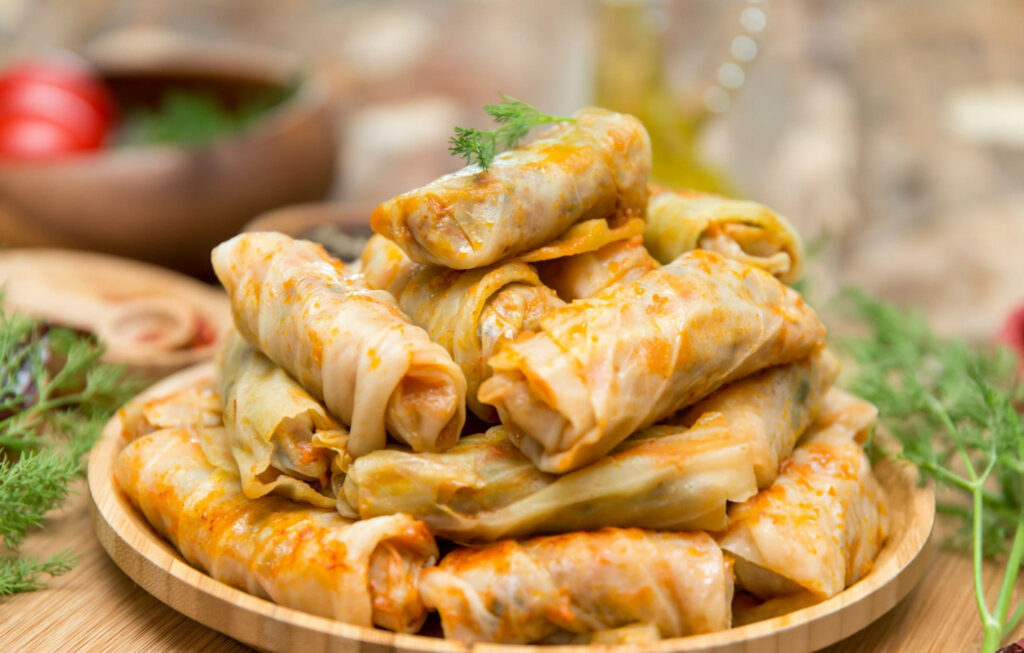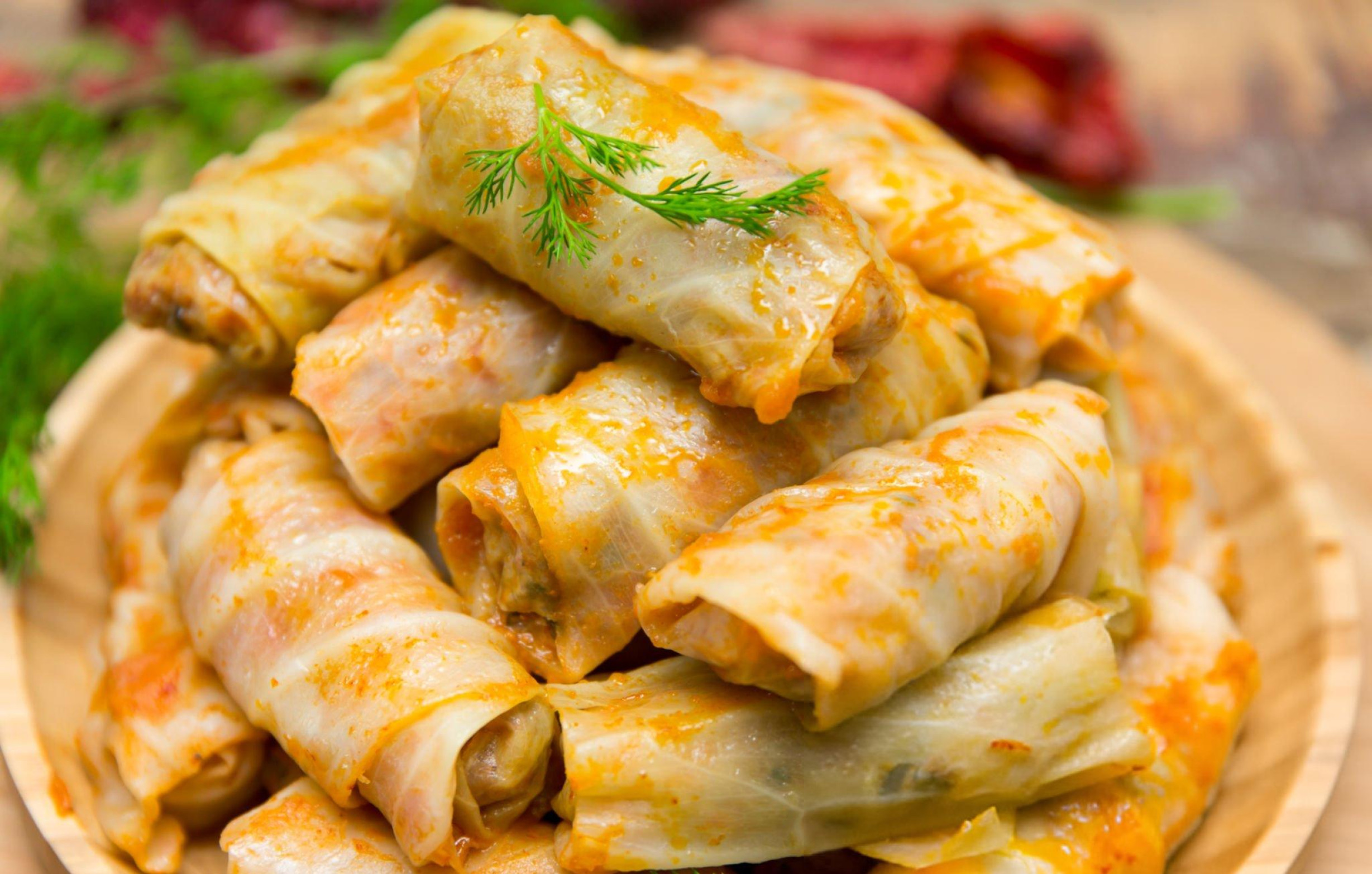Sarma Stuffed Cabbage Recipe
Few dishes evoke the essence of comfort quite like sarma—tender cabbage leaves wrapped snugly around a flavorful, savory filling. With each bite, you uncover layers of rustic charm and old-world tradition, where simple ingredients are transformed into a deeply satisfying meal. Sarma has the power to warm a table and anchor a gathering, offering not just nourishment but a sense of home and heritage.

Ingredient Breakdown
Every component of sarma plays a pivotal role in building its rich, comforting character, each layer contributing to the dish’s symphony of flavors and textures.
Cabbage is more than just a wrapper; it transforms in the cooking process, becoming supple and tender while subtly infusing the filling with its earthy undertones. Freezing and thawing the cabbage ahead softens the leaves naturally, eliminating the need for blanching and making them pliable for rolling.
The ground meat trio—lean beef, rich pork, and smoky ham—creates a filling that is simultaneously juicy and complex. The combination offers a perfect balance of flavor and fat, ensuring that the rolls stay moist during their long simmer.
Uncooked long-grain white rice is an essential binding element. It absorbs the savory juices released during cooking, lending a delicate bite and helping the filling maintain its structure without becoming heavy.
Aromatics and spices—finely chopped onion, salt, coarse black pepper, and a whisper of garlic powder—are all you need to season the filling. These straightforward ingredients allow the natural flavors of the meat to shine, enhanced rather than masked.
Tomato juice and sauerkraut form the flavorful base in which the rolls slowly cook. The tang of the sauerkraut and the acidity of the tomato juice cut through the richness of the meat, creating a beautifully balanced sauce that bathes the sarma in savory, mouthwatering depth.
If ingredients like ham or sauerkraut are out of reach, alternatives such as pancetta or pickled cabbage can serve as substitutes, offering similar layers of flavor without compromising the spirit of the dish.
Step-by-Step Preparation Guide
Start by carefully peeling the cabbage leaves away from the thawed head, taking care not to tear them. Each leaf becomes a vessel, and intact leaves ensure each roll holds its precious filling securely.
The filling is a harmonious blend of meats, rice, and seasonings. Mixing thoroughly by hand allows the textures to meld evenly, and shaping the mixture into compact, oval portions ensures uniform cooking and easy wrapping.
When wrapping, lay each leaf flat, place the filling near the base, and fold the sides inward before rolling tightly. This method guarantees that the rolls remain sealed during the long simmer.
Layer the bottom of a heavy pot with sauerkraut, creating a tangy bed that elevates the rolls slightly above the cooking liquid. Nestle the cabbage rolls seam-side down to keep them from unrolling, stacking if necessary. Pour the tomato juice over the top and add enough water to completely submerge the rolls.
Bring the pot to a gentle boil, then immediately lower the heat to a bare simmer. Allow the sarma to cook slowly and steadily, uncovered, for about three hours. Check periodically and top up with water as needed to ensure the rolls remain covered, preserving moisture and encouraging even cooking.

Recipe Tips
How to keep cabbage leaves pliable and easy to work with:
Freezing the cabbage for several days and thawing overnight breaks down the fibers, softening the leaves without the need for boiling, making them more flexible and less prone to tearing.
Getting the perfect meat-to-rice ratio for tender rolls:
Stick to one cup of rice for every two pounds of meat. Too much rice and the filling risks becoming dry; too little and it may lose its satisfying texture.
Layering techniques to avoid sticking and tearing during cooking:
Place a generous layer of sauerkraut at the bottom of the pot and always set the rolls seam-side down. If stacking, arrange each layer crosswise to prevent rolls from compressing each other.
Simmering secrets: maintaining flavor and moisture throughout:
Keep the pot at a very low simmer, not a boil. Vigorous boiling can toughen the cabbage and dry out the filling, while a gentle simmer ensures everything cooks slowly and remains tender.
What to Serve With This Recipe
Sarma’s hearty and savory character pairs beautifully with comforting sides like creamy mashed potatoes or a buttery polenta. Both absorb the flavorful juices and offer a mellow contrast to the robust rolls. A slice of warm, crusty bread also makes a perfect companion, ideal for sopping up every drop of the tangy tomato-sauerkraut sauce.
To balance the richness, serve sarma alongside a simple green salad with a sharp vinaigrette or a medley of pickled vegetables. Their acidity and crispness refresh the palate between bites, making each mouthful of sarma feel new again.
As for drinks, a crisp lager cuts through the richness with its carbonation, while a dry white wine like Sauvignon Blanc enhances the dish’s flavors without overwhelming them. Even a glass of sparkling water with a twist of lemon can bring a refreshing lift to the meal.
Creative Variations
Sarma is wonderfully adaptable. Swap the meat for ground turkey or chicken for a lighter version, or embrace plant-based alternatives like lentils and mushrooms to create a vegetarian variation that still satisfies.
For an extra layer of flavor, mix smoked paprika or fresh herbs like dill and parsley into the filling. Adding a bit of spicy sausage can lend a delightful kick, transforming the traditional rolls into something bold and exciting.
If you’re looking for a different texture, try baking sarma in the oven. Cover the rolls with foil and bake them slowly at a low temperature. This method yields a slightly drier but richly concentrated flavor, with a deeper caramelization of the tomato base.
Frequently Asked Questions
Can I use fresh cabbage instead of frozen?
Yes, but the leaves will need to be softened first by boiling the cabbage head in salted water until the outer leaves become pliable enough to peel away.
Is it possible to prepare sarma in advance and freeze it?
Absolutely. Assemble the rolls and freeze them before cooking, or freeze fully cooked sarma. Just be sure to thaw overnight in the refrigerator before reheating gently.
How long does sarma last in the refrigerator?
Sarma keeps well for up to four days when stored in an airtight container in the refrigerator. The flavors only improve as they meld over time.
What’s the best way to reheat leftovers without drying them out?
Place the sarma in a pot with a splash of water or tomato juice, cover, and reheat slowly over low heat. This method keeps the rolls moist and flavorful.
Sarma is a celebration of hearty flavors and timeless techniques, offering comfort in every tender bite. With its richly seasoned filling, delicate cabbage leaves, and tangy sauce, it brings a rustic elegance to the table. Whether enjoyed fresh from the pot or savored as a leftover delicacy, sarma deserves a cherished place in every home cook’s repertoire, delivering satisfaction and warmth no matter the occasion.

Ingredients
1 large head of cabbage, frozen for three days, then thawed overnight in the refrigerator
½ pound ground ham
1 pound lean ground beef
½ pound ground pork
1 cup uncooked long-grain white rice
1 egg
1 onion, finely chopped
1 teaspoon salt
1 teaspoon coarse ground black pepper
½ teaspoon garlic powder
1 pound sauerkraut
1 cup tomato juice
1 cup water, or more as needed to fully cover
Instructions
Carefully separate the leaves from the thawed cabbage head, ensuring they remain intact for easy wrapping.
In a large mixing bowl, combine the lean ground beef, ground pork, and ground ham. Add the uncooked rice, finely chopped onion, egg, salt, black pepper, and garlic powder. Mix thoroughly until all ingredients are evenly distributed, creating a well-blended filling. Shape the meat mixture into oval-shaped portions, using roughly ½ cup for each. Lay a cabbage leaf flat and tightly wrap it around the filling, tucking in the sides to form a secure roll.
Spread the sauerkraut evenly across the bottom of a heavy, large pot to create a tangy bed for the cabbage rolls. Arrange the stuffed cabbage rolls over the sauerkraut, placing them seam-side down to prevent them from unraveling during cooking.
Once all rolls are positioned, pour the tomato juice evenly over the top, allowing it to seep into the layers. Add enough water to cover the rolls completely. Set the pot over high heat and bring to a gentle boil. Once boiling, reduce the heat to low and simmer uncovered for approximately 3 hours. Keep an eye on the pot, adding more water if necessary to ensure the rolls stay submerged and cook evenly, resulting in tender cabbage and a richly flavored filling.

Sarma Stuffed Cabbage Recipe
Ingredients
- 1 large head of cabbage frozen for three days, then thawed overnight in the refrigerator
- ½ pound ground ham
- 1 pound lean ground beef
- ½ pound ground pork
- 1 cup uncooked long-grain white rice
- 1 egg
- 1 onion finely chopped
- 1 teaspoon salt
- 1 teaspoon coarse ground black pepper
- ½ teaspoon garlic powder
- 1 pound sauerkraut
- 1 cup tomato juice
- 1 cup water or more as needed to fully cover
Instructions
- Carefully separate the leaves from the thawed cabbage head, ensuring they remain intact for easy wrapping.
- In a large mixing bowl, combine the lean ground beef, ground pork, and ground ham. Add the uncooked rice, finely chopped onion, egg, salt, black pepper, and garlic powder. Mix thoroughly until all ingredients are evenly distributed, creating a well-blended filling. Shape the meat mixture into oval-shaped portions, using roughly ½ cup for each. Lay a cabbage leaf flat and tightly wrap it around the filling, tucking in the sides to form a secure roll.
- Spread the sauerkraut evenly across the bottom of a heavy, large pot to create a tangy bed for the cabbage rolls. Arrange the stuffed cabbage rolls over the sauerkraut, placing them seam-side down to prevent them from unraveling during cooking.
- Once all rolls are positioned, pour the tomato juice evenly over the top, allowing it to seep into the layers. Add enough water to cover the rolls completely. Set the pot over high heat and bring to a gentle boil. Once boiling, reduce the heat to low and simmer uncovered for approximately 3 hours. Keep an eye on the pot, adding more water if necessary to ensure the rolls stay submerged and cook evenly, resulting in tender cabbage and a richly flavored filling.

